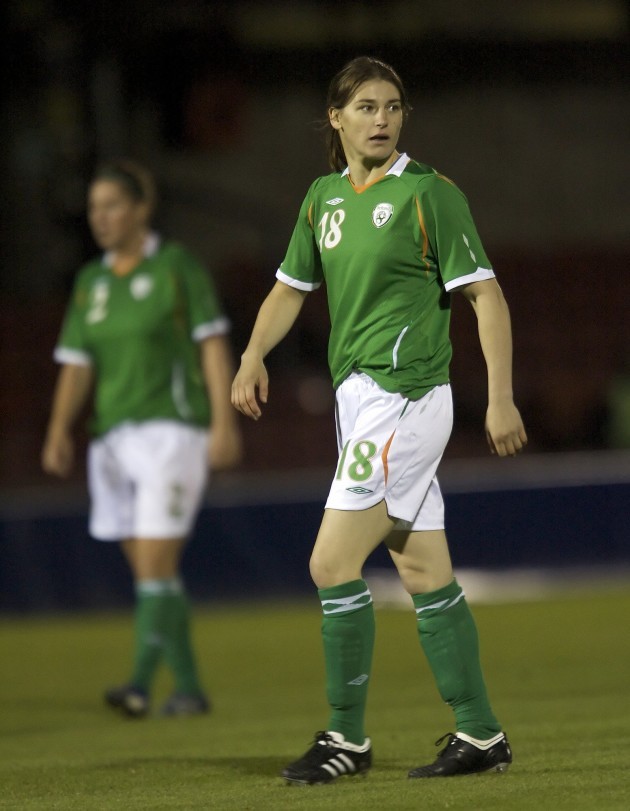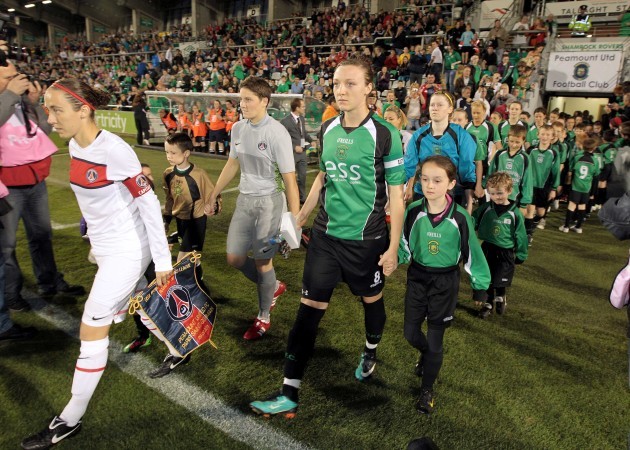RUTH COMERFORD WAS never going to become a millionaire playing football, but the memories she helped create and the people she met along the way are worth more than money.
From an early age, she was a street footballer, imitating Mark Hughes and other Manchester United players of the time.
Her father was “a baller all his life,” setting up clubs with friends in Killinarden after he moved from Rathfarnham to Tallaght.
The only one of her sisters who had an interest in soccer, at the age of around 11, Comerford joined a boys’ team, Jobstown Celtic.
“It was really hard,” she tells The42. “It was getting to that point where some of the lads were like: ‘Ugh, you’re a girl. Girls are shit at football. Girls can’t play.’ But then, when they saw that I could play, they kind of built respect for me. When I started scoring goals, they were all running and jumping and hugging me and all.”
Owing to the age cut-off point for girls playing boys’ football, Comerford then joined Lourdes Celtic, before subsequently lining out for St James’s Gate in the the Dublin Women’s Soccer League. It was there, as a 16-year-old, where she met current Ireland assistant boss Eileen Gleeson — a coach and friend who would have a significant influence on her career, and who managed the team alongside Brian Jones.
“There wasn’t an awful lot of money in women’s football, so he used to collect us for training,” she recalls. “And Eileen would be like that as well. She’d collect you and drop you back.
“It wasn’t getting buses left, right and centre. It was sitting in the back of a Jeep being brought to games.”
Notable players on the team included future Ireland internationals Susan Byrne and Katie Taylor, who of course is now among the most famous and successful Irish athletes on the planet, as a result of her countless achievements in boxing.
Katie was always a really fit player. She was well able to put in a challenge. If Katie was beside you, you knew that you were covered basically if you lost the ball. She’d have the legs on her to track back for you.
“Susan Byrne had the actual head for it. She just read the game so well. She was my favourite player. Not that she was lazy, she was that intelligent on the pitch that she didn’t have to make unnecessary runs.”
After St James’s Gate folded, Comerford joined one of the top Irish sides from that era — St Catherine’s. It was there that she met another influential figure in her career.
“[The coach] Brother Bernard was straight on, trying to get a couple of us in. So I played a couple of years with Catherine’s, which was fantastic, because Brother Bernard was just brilliant. He was all about the women’s game and progressing and getting you playing. He’d nearly be looking into the neighbour’s house: ‘Does she play football? Get her to play.’
“One thing that stood out to me about Brother Bernard was that the career I’m actually in today, he helped me start many moons ago. There was a fitness course and it was being held in Oliver Bond. There was the Liberties Training Centre there.
“Because I was from Tallaght, it was a bit controversial whether I would get a slot. He actually recommended that I go. And so, I applied and got it.
“I did my fitness qualification through the Liberties Training Centre about 15 years ago, and that kind of got me started. I’m a sports promotion officer now for the Kildare and Wicklow Education and Training Board. That was my little stepping stone.
“So I always think of him, when I think back to when I was starting out wondering what to do with my life. That was something I’ll always be grateful for. I don’t think he even knows that — he put me on the right path.”
She continues: ”He’s an absolute gem. They just don’t make them like they used to. It was the same with Brian Jones and Eileen. They were really all about women’s football and improving it, the passion and it was pure old school. Bernard was great because he had a bus, so we were all sorted for our lifts for all the games, which saved money as well. And then we did an awful lot of fundraising and sponsor cards, if we needed to get games and stuff.
The game in itself has developed so much, but then it’s like, people are out there and they work in the game, but do they have the passion for the game? That’s what I had. We didn’t have the money, but we had the passion. I’m not taking it away from some coaches who probably have both. But back then, you had to have the passion, and that’s what got us through not having the money.”
There were opportunities to go abroad on a scholarship and to potentially play in England, but Comerford was always a “home bird” and the financial incentives of playing across the water were not as strong then as they are now.
“The one thing I would have liked was to have a cap for the senior Irish team,” she adds. “When I was with the 19s, I had gone on and was selected to do a course, so I actually moved to Belfast. Then I went on to live in Montreal for a couple of months. If there had been a window of opportunity, it would have been in that time.
“I decided to do a course, and when I came back then, people had progressed into senior level, and I was kind of forgotten about.
“There was a huge amount of girls coming through, and that would have been one of the single opportunities and probably the only opportunity that was available — you imagine the amount of girls that would have sold their granny to get onto the Irish team.
“Without wanting to sound cocky, when I was good, I was fantastic. If I’d have gotten an opportunity of being seen at my top performance in midfield, I’d have been pulled in. I might not have started in the XI, but I’d have been part of the squad.
“With the Irish team back then, the managers were the same for a very long time. So they had their players in their head [to select] and unfortunately, you can only have a squad of about 20.”
In 2009, Comerford joined Peamount United, once again linking up with Gleeson. The following year, they won a remarkable treble, encompassing the Dublin Women’s Soccer League title, the DWSL Premier Cup and the FAI Women’s Cup.
The squad included the talented likes of Nicola Sinnott, Aine O’Gorman, Karen Duggan, Sara Lawlor, and Louise Quinn. As a result of their domestic achievements, the team qualified for the Champions League group stages in both the 2011-12 and 2012-13 seasons, reaching the last 32 on the former occasion.
“It was such a huge moment for the club, and for management and players. The hard work had paid off and the 12 hours of fucking backpacking I did paid off as well. There are an awful lot of things you do behind the scenes that, when you get such a reward like that at the end of it, it was so worth those 12 hours packing random people’s bags.
I remember I had to have a conversation with Eileen, because I was disappointed I didn’t start any of the group games. Eileen would be a friend and I was able to sit and have a conversation if I was pissed off and wasn’t happy about something. I wouldn’t be a child and throw my toys out of the pram if we lost. It’d be very healthy competitiveness, that’s the way I always was.
“But we came back, we qualified and the draw [in the last 32] was against PSG. She started me in the two games, the home and away leg, and I was like: ‘Those were the most important games of my life.’
“I was like: ‘She didn’t start me in the group stages.’ Obviously, she had watched the other team and decided ‘Ruth’s going to slot in,’ so it wasn’t a thing that I wasn’t good enough. It was like, someone else was in to do this job, but when a position and a game comes up where I need you to do your job, you’re going to be pulled in, and I actually played really well in both legs, even though we got hammered.
“We got to go to Slovenia and Paris [for matches], that was the first one, and then the second time we went to Bosnia, which was just unbelievable.”
The fact that, increasingly, domestic players who show promise are opting to play club football in Britain means Peamount’s Champions League achievement of reaching the knockout stages is unlikely to be emulated anytime soon, and Comerford understands why Irish footballers would rather go abroad.
“If you’re going to be paid for something that you love to do, why not do it?
“You would hope that in the coming years, the younger girls coming through would be like: ‘I want to play for Peamount.’
“If there’s such a huge buzz about the clubs we have here in Ireland, the National League will grow and they won’t be looking to move so quickly.”
Perhaps the player who subsequently enjoyed the most success in football from that era is Louise Quinn, now a regular at centre-back for Ireland, and whose career has included stints at Arsenal and current club Fiorentina.
“Louise is a player that would work really hard for you. If there was something not happening in her game, she’d go off and work on it. It was the same with Aine [O'Gorman] as well.
“Back then, Louise Quinn to me was Louise Quinn. Now, she’s played for Arsenal, she’s really progressed in her career, but starting out, she was always a solid midfielder.
“She was quite known for heading the ball as well, which was great, because I hated heading the ball.
“So it was nice to play with Louise. But compared to what she’s like now to what she was 10 years ago, I think she’s after improving her game 100%. But it’s still lovely to say: ‘Oh jeez, I played with Louise Quinn in the middle.’”
Comerford opted to end her career in the Women’s National League in 2015, with the responsibilities increasing in her day job, meaning she could no longer devote the many hours required to excel in senior football.
She has since played at a more casual level for Ballyfermot, Harbuck Street and most recently Terenure, who she also does some coaching with, having completed her Uefa B licence last year, although she is pregnant now and taking a break from football.
As is so often the case with female footballers in this country, she dropped out of elite level at a relatively early age, not long after turning 30. Increasingly, she explains, life gets in the way and with other priorities, dedicating yourself to sport becomes more difficult to justify.
“If you’re in a good job that accepted it, they might give you a bit of time off.
I remember being in a job and I had to take unpaid leave to play in the Champions League.
“I spent nearly 22 years playing club football. I’m 36 and when I have the baby, I’ll go back and play club football again until I can’t. Then I’ll probably move on to the coaching side.
“But the elite side does take an awful lot of your time. You need to sit down and say: ‘Right, do I want to go here 100%, or do I want to go with the career?’ So definitely, life does kind of stand up in front of you and go: ‘Right, what’s the craic? What are we doing? Are we going to play football for the rest of our lives, or are we going to get our shit together?’”





